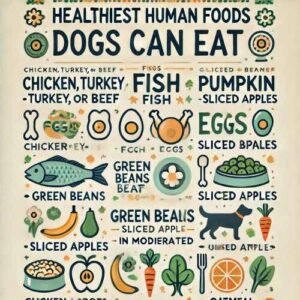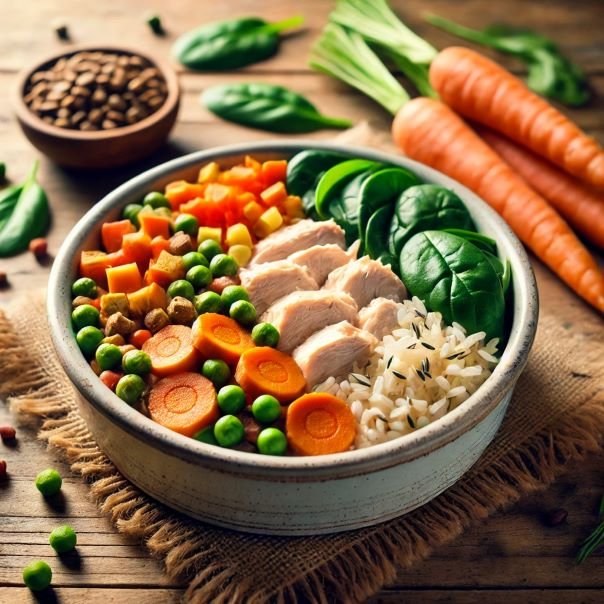Dogs on the Biologically Appropriate Raw Food (BARF) diet eat raw fruits, vegetables, meats, and bones. Supporters believe this diet closely resembles what wild dogs naturally eat.
Comparison of benefits and Risks of Raw Diet
| Benefits of the Raw Diet | Risks of the Raw Diet |
|---|
| Improved Coat Condition: Shinier coats and healthier skin indicate overall well-being. | Nutritional Imbalance: Without careful planning, essential nutrients might be missed, affecting your dog’s health. |
| Better Dental Health: Chewing raw bones helps remove plaque and tartar, improving teeth and gums. | Bacterial Contamination: Raw meat may contain harmful bacteria like Salmonella and E. coli, posing health risks. |
| Increased Energy Levels: Some dogs display higher energy and stamina, making them more playful and active. | Bone Hazards: Certain bones can splinter, causing serious injuries if not carefully selected. |
Cooked Diets: Safe and Nutritious Options
Cooking dog food at home can lower the risk of bacterial contamination while still allowing for meal customization. This makes cooked diets a safer option compared to raw diets.
Comparison Table: Benefits and Risks of Cooked Diets for Dogs
| Benefits of Cooked Diets | Risks of Cooked Diets |
|---|
| Reduced Risk of Bacterial Infection: Cooking eliminates harmful bacteria, making meals safer for your pet. | Nutritional Balance: Achieving the right balance of nutrients can be challenging and requires careful planning. |
| Customization: Cooked meals can be tailored to your dog’s specific needs, addressing individual health concerns. | Expense: High-quality ingredients and proper preparation can be costly, making this option expensive. |
Commercial Alternatives to Traditional Dog Food
If you’d rather stick with commercial products but are searching for alternatives, there are several options that provide high-quality ingredients and tailored diets.
Benefits and Risks of Freeze-Dried Foods for Dogs
| Benefits | Risks |
|---|
| Nutrient Retention: Freeze-drying removes moisture while preserving nutrients, flavor, and texture, retaining most vitamins and minerals. | Rehydration Needs: Must be rehydrated before consumption, which can take time and lead to an unpalatable texture if done improperly. |
| Long Shelf Life: Can last for many years when stored properly, making them ideal for emergency preparedness and camping. | Cost: More expensive than fresh or dehydrated foods due to complex processing involved. |
| Convenience: Lightweight and easy to transport; can be quickly rehydrated with water for fast meal preparation. | Storage Requirements: Should be stored in a cool, dry place in airtight containers to maintain shelf life and nutritional quality. |
| Taste and Variety: Maintains a taste similar to fresh foods, offering a wide variety of options, including fruits, vegetables, and meals. | |
Canned Food
| Category | Details |
|---|
| Enhanced Taste and Aroma | Canned foods generally have a richer taste and aroma, making them more appealing to picky eaters. |
| Easier Digestion | Many dogs find canned food easier to digest, especially those with gastrointestinal or dental issues. |
| Hydration | Canned dog food has high moisture content, helping keep dogs hydrated. |
| Variety of Flavors and Textures | Available in numerous flavors and textures, catering to dogs’ preferences. |
| Nutritious Formulations | Many canned foods contain quality ingredients, providing essential nutrients for dogs’ health. |
| Higher Water Content | Less calorie-dense than dry kibble, which may require larger portions to meet dietary needs. |
| Cost Considerations | Canned foods are generally more expensive, potentially increasing monthly pet food budgets. |
| Storage and Spoilage | Once opened, they must be refrigerated and consumed within a few days to avoid spoilage. |
| Potential for Weight Gain | Lower calorie density may lead to unintentional overfeeding, causing weight gain. |
| Dental Health Impact | Canned foods don’t provide abrasive action, requiring more dental care to maintain oral health. |
Grain-Free and Limited Ingredient Diets
Benefits:These diets are helpful for dogs with allergies or sensitivities to grains or certain ingredients, giving you more choices.
Risks:Nevertheless, Not all grain-free diets are the same. Some might miss important nutrients, so it’s crucial to choose carefully.
Commercial Supplements and Additives
Supplements can improve overall health and target specific problems for your dog.
Common Supplements
Fish Oil: Rich in Omega-three fatty acids (EPA and DHA), fish oil helps pores and skin and coat fitness and decreases irritation.
Forms Available: Liquid, tender gels, and chewable capsules.
Probiotics: Live micro organism that sell intestine fitness, resource digestion, and beautify the immune system.
Forms Available: Powders, capsules, chewables, and integrated into a few canine foods.
Joint Supplements:Typically incorporate glucosamine, chondroitin, and MSM to assist joint fitness and mobility.
Forms Available: Tablets, chewables, tender gels, and powders.
Multivitamins:Comprehensive dietary supplements that offer critical nutrients and minerals to assist average fitness.
Forms Available: Tablets, chewables, powders, and liquid formulations.
Digestive Enzymes : Help destroy down food, enhancing nutrient absorption and helping in digestion, in particular for puppies with touchy stomachs.
Forms Available: Powders and capsules.
Calcium Supplements :Provide extra calcium to assist bone fitness, in particular in developing dogs or puppies with unique nutritional needs.
Forms Available: Tablets, chewables, and powders.
Antioxidants: Supplements containing nutrients E and C, selenium, and different compounds that assist fight oxidative strain and assist immune function.
Forms Available: Capsules, tablets, and powders.
Hemp Oil/CBD Oil: Derived from hemp, this oil might also additionally assist with anxiety, ache relief, and irritation in puppies.
Forms Available: Oils, capsules, and treats.
Vitamin E:An antioxidant that helps pores and skin fitness, immune function, and can sell a healthful coat.
Forms Available: Capsules and liquid drops.
L-Carnitine :An amino acid that enables with fats metabolism and helps weight control in high weight puppies.
Forms Available: Tablets and powders.
Risks and Considerations
Over-Supplementation:It’s important to remember that giving too much of a supplement can be bad for your dog. So, always use them in moderation.
Quality Control:Additionally,What Can I Feed My Dog Instead of Dog Food?Not all supplements are checked for quality, so they can be very different from each other. That’s why it’s important to pick trusted brands.
Transitioning Your Dog to a New Diet
To avoid an upset stomach, change your dog’s food slowly. Gradually mix the new food with the old food over several days.

Steps for a Smooth Transition
Gradual Introduction:First, mix a small amount of the new food with the old food, gradually increasing the new food over several days.
Monitor Health:Next, watch for any signs of digestive issues or allergies during the transition.
Consult Your Vet: Finally, Talk to a veterinarian to make sure the new diet is right for your dog’s nutritional needs. This will help you choose the best options for your furry friend.
Conclusion:


